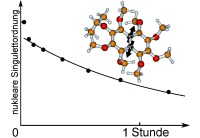- Record: found
- Abstract: found
- Article: not found
A Nuclear Singlet Lifetime of More than One Hour in Room‐Temperature Solution†

Read this article at
Abstract
Nuclear magnetic resonance (NMR) and magnetic resonance imaging (MRI) are supremely important techniques with numerous applications in almost all branches of science. However, until recently, NMR methodology was limited by the time constant T 1 for the decay of nuclear spin magnetization through contact with the thermal molecular environment. Long‐lived states, which are correlated quantum states of multiple nuclei, have decay time constants that may exceed T 1 by large factors. Here we demonstrate a nuclear long‐lived state comprising two 13C nuclei with a lifetime exceeding one hour in room‐temperature solution, which is around 50 times longer than T 1. This behavior is well‐predicted by a combination of quantum theory, molecular dynamics, and quantum chemistry. Such ultra‐long‐lived states are expected to be useful for the transport and application of nuclear hyperpolarization, which leads to NMR and MRI signals enhanced by up to five orders of magnitude.
Translated abstract
Lang lebe der Spin: Ein molekulares System basierend auf einem 13C 2‐markierten Naphthalin‐Kern wurde hergestellt, das in Lösung eine langlebige Singulett‐Kernspinordnung unterstützt. Ein Singulett‐Kernspin mit einer Lebensdauer von über einer Stunde konnte in Lösung bei Raumtemperatur beobachtet werden.
Related collections
Most cited references13
- Record: found
- Abstract: found
- Article: not found
Beyond theT1Limit: Singlet Nuclear Spin States in Low Magnetic Fields
- Record: found
- Abstract: not found
- Article: not found
Applications of dynamic nuclear polarization in 13C NMR in solids
- Record: found
- Abstract: found
- Article: not found

